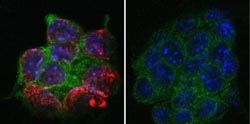Scientists find missing link between players in the epigenetic code

Mouse embryonic stem cells (blue, green) lose DNA methylation (red) in the absence of UHRF1.<br><br>Credit: Strahl Lab, UNC School of Medicine<br>
As researchers have uncovered more and more of these “epigenetic” tags, they have begun to wonder how they are all connected. Now, research from the University of North Carolina School of Medicine has established the first link between the two most fundamental epigenetic tags — histone modification and DNA methylation — in humans.
The study, which was published Sept. 30, 2012 by the journal Nature Structural & Molecular Biology, implicates a protein called UHRF1 in the maintenance of these epigenetic tags. Because the protein has been found to be defective in cancer, the finding could help scientists understand not only how microscopic chemical changes can ultimately affect the epigenetic landscape but also give clues to the underlying causes of disease and cancer.
“There's always been the suspicion that regions marked by DNA methylation might be connected to other epigenetic tags like histone modifications, and that has even been shown to be true in model organisms like fungus and plants,” said senior study author Brian Strahl, PhD, associate professor of biochemistry and biophysics in the UNC School of Medicine and a member of UNC Lineberger Comprehensive Cancer Center. “But no one has been able to make that leap in human cells. It's been controversial in terms of whether or not there's really a connection. We have shown there is.”
Strahl, along with his postdoctoral fellow Scott Rothbart, honed in on this discovery by using a highly sophisticated technique developed in his lab known as next generation peptide arrays. First the Strahl lab generated specific types of histone modifications and dotted them on tiny glass slides called “arrays.” They then used these “arrays” to see how histone modifications affected the docking of different proteins. One protein – UHRF1 – stood out because it bound a specific histone modification (lysine 9 methylation on histone H3) in cases where others could not.
Strahl and his colleagues focused the rest of their experiments on understanding the role of UHRF1 binding to this histone modification. They found that while other proteins that dock on this epigenetic tag are ejected during a specific phase of the cell cycle, mitosis, UHRF1 sticks around. Importantly, the protein's association with histones throughout the cell cycle appears to be critical to maintaining another epigenetic tag called DNA methylation. The result was surprising because researchers had previously believed that the maintenance of DNA methylation occurred exclusively during a single step of the cell cycle called DNA replication.
“This role of UHRF1 outside of DNA replication is certainly unexpected, but I think it is just another way of making sure we don't lose information about our epigenetic landscape,” said Strahl.
The research was funded by the National Institutes of Health and the North Carolina Biotechnology Center.
Study co-authors from UNC were Scott B. Rothbart, PhD, a postdoc in Strahl's lab at UNC; Krzysztof Krajewski, PhD, research assistant professor; and Jorge Y. Martinez, a former student in Strahl's lab.
Media Contact
More Information:
http://www.unch.unc.eduAll latest news from the category: Life Sciences and Chemistry
Articles and reports from the Life Sciences and chemistry area deal with applied and basic research into modern biology, chemistry and human medicine.
Valuable information can be found on a range of life sciences fields including bacteriology, biochemistry, bionics, bioinformatics, biophysics, biotechnology, genetics, geobotany, human biology, marine biology, microbiology, molecular biology, cellular biology, zoology, bioinorganic chemistry, microchemistry and environmental chemistry.
Newest articles

Recovering phosphorus from sewage sludge ash
Chemical and heat treatment of sewage sludge can recover phosphorus in a process that could help address the problem of diminishing supplies of phosphorus ores. Valuable supplies of phosphorus could…

Efficient, sustainable and cost-effective hybrid energy storage system for modern power grids
EU project HyFlow: Over three years of research, the consortium of the EU project HyFlow has successfully developed a highly efficient, sustainable, and cost-effective hybrid energy storage system (HESS) that…

After 25 years, researchers uncover genetic cause of rare neurological disease
Some families call it a trial of faith. Others just call it a curse. The progressive neurological disease known as spinocerebellar ataxia 4 (SCA4) is a rare condition, but its…





















